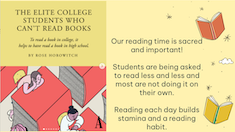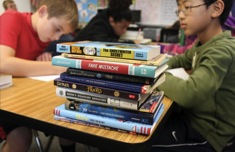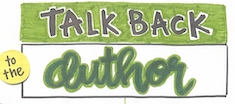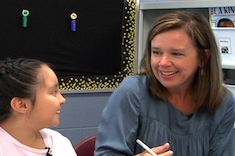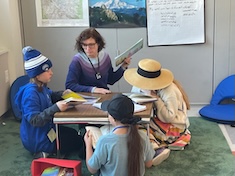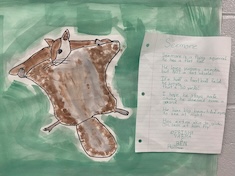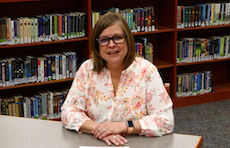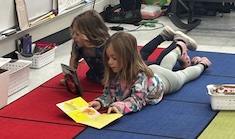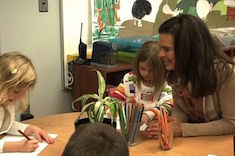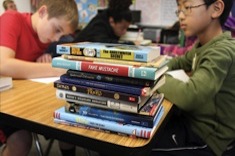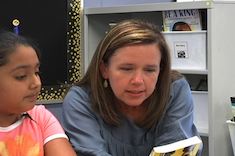Teaching Reading
Our contributors lead reading workshops in classrooms with creative flair. Over the past 12 years, we've filled our site with loads of suggestions, tools, and tips for using engaging books throughout the curriculum to hook kids on reading. Here is where you will find many stories of successful and not-so-successful workshop days, and what we learned from them. We bring these stories to life through hundreds of video examples.
Latest Content
Making the Case for Reading
Gretchen Schroeder makes a case for independent reading to administrators, families, and her high school students. Gretchen offers notebook entries, scholarly articles, and whole-class activities to help everyone know the benefits of consistent, daily independent reading.
Latest and Greatest Ways to Show Independent Reading Is Valued
Even as the pressure to add more whole-class reads and articles with focused reading lessons closes in around us with pressure from administrators and school boards, Tara Barnett and Kate Mills are committed to finding ways to get books into students’ hands and show how much they value reading. Here are some of their best tips for keeping the choice in reading—as well as the love of reading—alive.
Talking Back: A Strategy for Annotation
Tiffany Abbott Fuller gives us everything we need to use an active reading strategy. By the time you finish reading this article, you’ll be prepared to teach this strategy, equipped with sentence stems for students, specific ideas for instruction, and an anchor chart for visual reference.
Hidden Lessons: Why Do Relationships Matter? (Part 3)
By the time they reach high school, many students have learned how to survive change, but not always how to make sense of it. They’ve lost friendships, switched schools, experienced family transitions, or even dealt with grief. While they may not always talk openly about these experiences, they often find reflections of them in the books they read. Gretchen Schroeder continues her series about using literature to help students learn important social and relationship skills. She includes student work and a booklist.
Wheels: Adapting to Change on the Roller Derby Track and in Your Teaching Life
Gwen Blumberg is inspired by a challenging roller derby practice and sees parallels for teachers who are facing challenging situations with changes to literacy curriculums. If something is shifting in your life, this article is sure to offer you confidence in moving forward.
Walking a Teaching-Readers Tightrope: Finding Balance Between Beliefs and Expectations
Hannah Tills offers a much-needed metaphor for all teachers who are implementing a new curriculum resource. Rather than thinking of the new expectations as part of a pendulum, Hannah encourages us to think of walking a tightrope. She offers ways to stay rooted in student engagement, student access, student choice, and teacher autonomy while also meeting expectations of a newly adopted curriculum program.
Books Are My Management Strategy
Becca Burk reflects on the power of reading as a way to set routines and help nourish healthy regulation.
Five Things I’ve Used AI for This Week
From lesson planning to generating decodable texts, Dana Murphy shares five ways she uses AI as a reading interventionist.
The Influence of the Classroom Library
Heather Fisher writes a bold article addressing the many questions educators are facing about their values and beliefs when it comes to our classroom libraries in this time of a heavy emphasis on phonics instruction and decodable books.
Helping Kids Lead Every Day: How to Deepen Small-Group Discussions
Tammy Mulligan shares the step-by-step process she uses with her fourth-grade students so that their small groups are fully managed by students and her teaching is focused on their needs as readers. This is the second installment of a three-part series.
Now What? We Went on a Field Trip
Mandy Robek thoughtfully connects a field trip to multiple literacy experiences in her second-grade classroom. If you’re looking to leverage the field trip experience for reading and writing, you’ll love Mandy’s process.
Expecting Joy in the Classroom Library
Bitsy Parks shares the joy you can expect from the classroom library.
Meaning Makers
Josie Stewart and Hannah Tills push against the adage that “early readers are focused solely on learning to decode, while later readers are making meaning.” Instead they remind us of the beautiful way all readers are meaning makers.
Zooming In and Stepping Back
Gretchen Schroeder creatively leads her students in chronicling key scenes from a novel so they can evaluate which ones are important and use it as a reference throughout their discussions.
Literary Salons: Book Clubs, Elevated
Inspired by the 17th-century popularity of literary salons, Gretchen Schroeder changed the usual book club routine for her high school students. Literary salons allow people to explore big topics and ideas together without reading the same book. They can create engaging discussions, expose students to new ideas and books, and give them the chance to learn from one another in a relaxed way.
Pick One: How to Establish a Community of Readers
“Pick one!” These are the words that begin to grow a community of readers. When students say, “I’m done,” Becca Burk points toward the classroom library and encourages them to pick a book and begin growing strong roots as a reader.
Reclaiming Space: Weeding to Grow a Healthy Library
Books, like gardens, need to be tended to regularly for the whole library to thrive. Gigi McAllister gives tips for anyone in the weeding process for their school or classroom library.
You Know How to Show Them
Becca Burk tackles the issues associated with distraction when it comes to helping students engage with a book rather than a device.
Story Walks
Christy Rush-Levine invites students into a story walk. While many of our school activities require students to sit still and be quiet, story walks with wordless books are a simple way to invite students to move and talk, with powerful outcomes.
Tips for Interactive Word Study
Lisa Mazinas offers tips for building fluency in elementary readers.
Fluency Practice in Middle School
Leigh Anne Eck tackles fluency strategies with her middle school readers.
Responding to Appeals for Help
Dana Murphy outlines three options to respond to a student who is stuck when reading and looking to the teacher for the answer. By being mindful when students appeal for help, we can make intentional, on-the-spot decisions to empower students to become better readers.
An Invitation to Elevate Readers’ Thinking Through Conversation
Melissa Quimby offers structures to help elevate readers’ thinking through book club conversations. You’ll love putting these practical ideas into play in your own classroom—and be awed by the depth of your readers’ understandings.
Writing About Reading
Mandy Robek is on a quest to make writing about reading feel natural with her elementary students. She shares practical ways to help students change the way they approach writing about reading to lift the level of comprehension and conversation.
Developing Reader Identities: It Is More Than Magic
Becca Burk reminds us of the importance of building a reading identity within all students so they can become stronger readers.
When They’re Hard to Teach
Cathy Mere reminds us of the complexities of teaching readers, especially those who are in intervention. She shares the “rules” she’s put in place for herself when a rough patch is hit and little growth is gained.
When Reading Practices Drift
When Leigh Anne Eck noticed her students’ reading practices weren’t as robust as she expected, she realized she was the one who had drifted away from key instructional practices. Leigh Anne offers several ways to support students in their independent reading lives.
Three Archetypes as Advocates for the Science of Reading
Matt Renwick defines three archetypes of personalities he has observed who have incomplete understandings about the science of reading. Matt offers approaches to each person, and notes that no one person neatly fits into a simple archetype.
My Teaching Toolbox (Part 2)
Dana Murphy reminds us that having a teaching toolbox makes planning efficient and effective. In this second installment of a two-part series, Dana offers two additional approaches to delivering strong reading instruction.
Small Shifts That Make a Big Difference
Dana Murphy names two practices that made a big difference in her work as a reading specialist. You may be surprised at the simplicity and smallness that led to powerful gains in her readers.
Browse Content By
Type
Category
- Assessment Tools
- Big Fresh Archives
- Booklists
- Choice Numeracy
- Classroom Design
- Common Core
- Community Building
- Conferring
- Content Literacy
- Digital Literacy
- English Language Learners
- Equity
- Family Relations
- Free Samples
- Guiding Groups
- Leadership
- Literacy Coaches
- Mentor Texts
- Minilessons
- New Teacher Mentors
- Podcasts
- Poetry
- Quote Collections
- Reading Strategies
- Self Care
- Struggling and Striving Learners
- Talking and Listening
- Teacher Study Groups
- Teaching Reading
- Teaching Writing
- Word Study and Vocabulary
Author
- Melissa Quimby
- Nawal Qarooni
- Gwen Blumberg
- Julie Cox
- The Lead Learners
- Hannah Tills
- Josie Stewart
- Ruth Metcalfe
- Mallory Messenger
- Becca Burk
- Jodie Bailey
- Vivian Chen
- Mary Brower
- Tiffany Abbott Fuller
- Stephanie Affinito
- Ruth Ayres
- Leigh Anne Eck
- Heather Fisher
- Shari Frost
- Julie Johnson
- Suzy Kaback
- Gigi McAllister
- Shirl McPhillips
- Melanie Meehan
- Cathy Mere
- Debbie Miller
- Tara Barnett and Kate Mills
- Tammy Mulligan
- Dana Murphy
- Bitsy Parks
- David Pittman
- Brenda Power
- Heather Rader
- Matt Renwick
- Mandy Robek
- Christy Rush-Levine
- Gretchen Schroeder
- Jen Schwanke
- Brian Sepe
- Katherine Sokolowski
- Stella Villalba
- Jennifer Vincent
Grade Level
Choice Literacy Membership
Articles
Get full access to all Choice Literacy article content
Videos
Get full access to all Choice Literacy video content
Courses
Access Choice Literacy course curriculum and training

